
Original Link: https://www.anandtech.com/show/2968/intel-s-x25-v-kingston-s-30gb-ssdnow-v-series-battle-of-the-125-ssds
Intel's X25-V & Kingston's 30GB SSDNow V Series: Battle of the $125 SSDs
by Anand Lal Shimpi on March 19, 2010 12:00 AM EST- Posted in
- Storage
The story goes like this: Intel let Kingston build a value version of its X25-M G2 drives. This became the 40GB Kingston V Series Boot Drive. When Intel added TRIM support to the G2 drives, Kingston was told to wait. Kingston would get TRIM support when Intel launched its own 40GB version of the G2. Here’s where things get hairy. Intel and Kingston couldn’t work out terms for the TRIM enabled firmware on the V Series Boot Drives. Intel wanted too much money and Kingston wanted to keep the drive price below $100. The outcome? Kingston V Series Boot Drive owners never got official TRIM support and the product was dropped altogether.
This all took place a few months ago. Two things have happened since then. Intel has, as expected, launched its value SSD: the X25-V. This is basically the Kingston drive we reviewed last year, but with official TRIM support. In other words, it’s a X25-M G2 but with only half the channels populated with IMFT NAND. The X25-V is available only in a 40GB capacity (we’ll see an 80GB version based on 25nm NAND in Q4 2010). The drive is priced at $125 and available today. On a side note, Intel’s pricing shows that there wasn’t any room for Kingston to deliver a sub-$100 version of the X25-V.
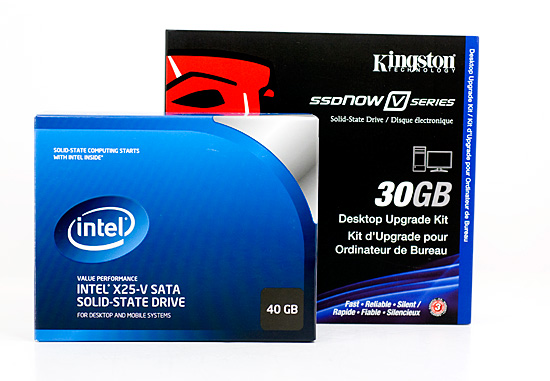
The second thing to happen was that Kingston built another V Series Boot Drive, this time based on a Toshiba controller with 32GB of MLC NAND on board. The price? $124.99 for an upgrade kit. Kingston appears to be going head to head with Intel in the value SSD space. Ballsy. Update: Kingston has pointed out that despite the $124.99 MSRP, Newegg is currently selling the drive for $114.99 with an additional $30 mail in rebate that will drop the total price to $84.99 after rebate.
Meanwhile, OCZ recently announced its Onyx SSD based on a newer low cost Indilinx controller. The target price? Sub-$100. Unfortunately we’ll have to wait a little longer on it as the final firmware is still being ironed out. Instead, today’s comparison takes place exclusively at $125 and is between Intel and Kingston. Former bedmates, the two now have equally compelling entry-level SSD offerings.
V for Vende...Value
This is the first time I’ve actually received a retail boxed Intel SSD. The packaging actually mimics that of Intel’s boxed CPUs:
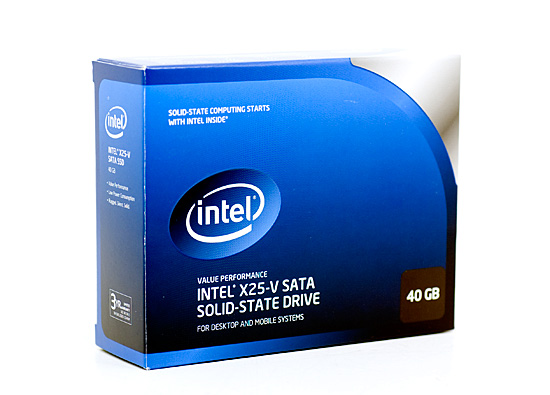
Inside the retail package you’ll find a full upgrade kit. You get a 3.5” mounting plate, a mini CD with an installation guide on it, one of those My SSD Rocks! stickers and the drive itself.
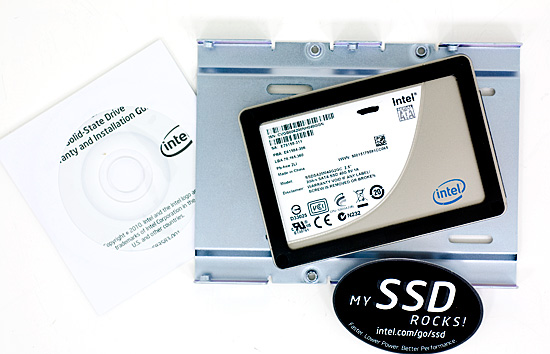
The X25-V ships in the same aluminum housing as the X25-M G2. Cracking it open reveals a bare side of the PCB:
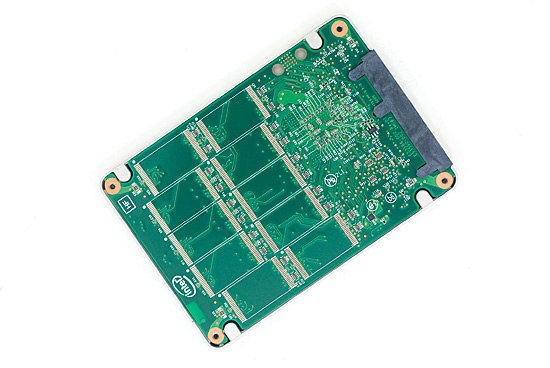
Flipping it over we see the 5 x 8GB 34nm IMFT flash modules, the G2 controller and 32MB of PC133 SDRAM. The controller and SDRAM size/speed are identical to the 80 and 160GB G2s we reviewed last year.
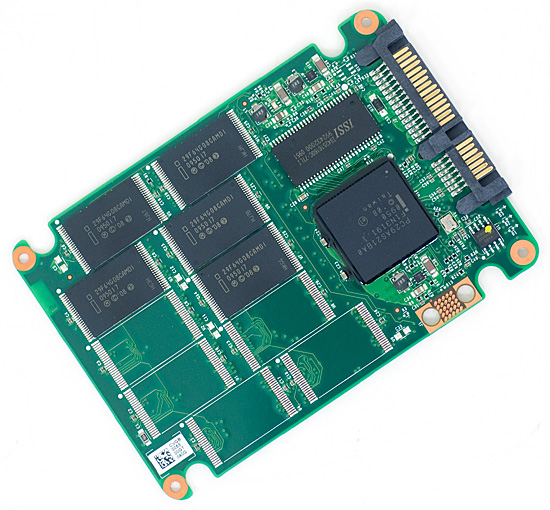
Intel's X25-V PCB
With only half the channels populated, sequential write speed is about half of the X25-M G2 (~40MB/s vs. ~80MB/s). Remember that Intel’s controller uses free space as spare area, so with potentially less free space on the drive the 40GB X25-V will undoubtedly perform much worse than the 80GB or 160GB X25-Ms.
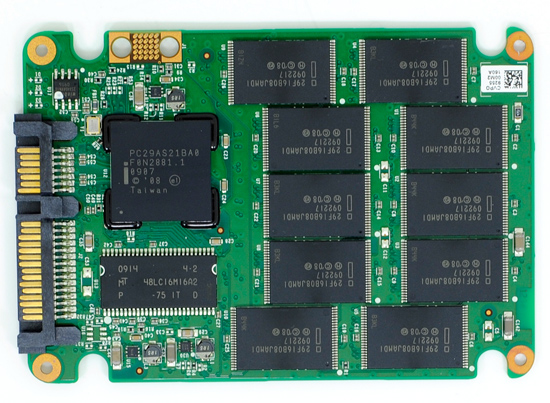
Intel's X25-M G2 PCB
In practice, the X25-V should perform very much like last year’s 40GB Kingston V Series Boot Drive. The two are identical minus official support for TRIM in the X25-V’s firmware.
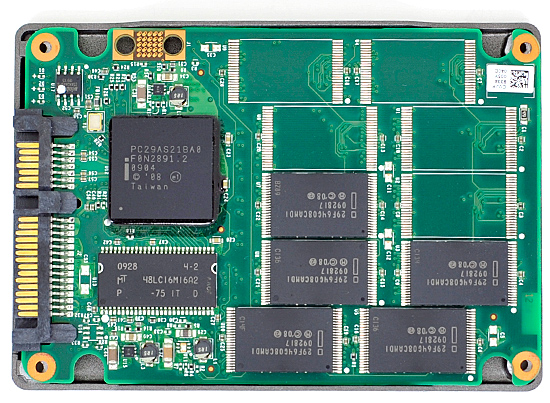
Kingston's 40GB V Series Boot Drive PCB
Intel’s storage drivers (Intel RST 9.6) with TRIM support are expected to be available any day now so you’ll no longer have to rely on Microsoft’s AHCI drivers for TRIM.
Kingston’s 30GB SSDNow V Series Boot Drive
For $125, Kingston will sell you more of an upgrade kit than Intel will. The new 30GB V Series Boot Drive upgrade kit comes with 3.5” mounting brackets, cloning software, a molex to SATA power cable, a SATA data cable and the drive itself. If you just want the drive, Kingston will sell it to you for $110.
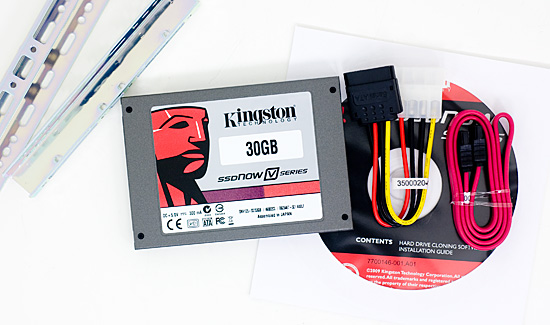
Inside the drive is a ridiculously small PCB screwed on so tight that I couldn’t even remove it for a look at the back.
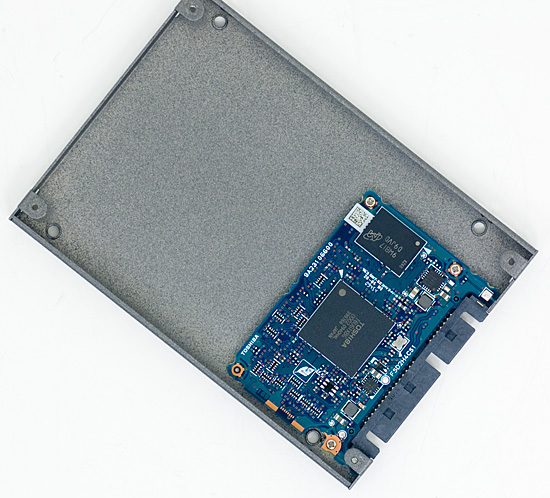
The Toshiba T6UG1XBG controller on this drive is the same controller used in the latest Kingston SSDNow V+ Series drives. It supports TRIM but not NCQ, although as I found in my testing of the V+ drives the TRIM functionality is a bit odd.
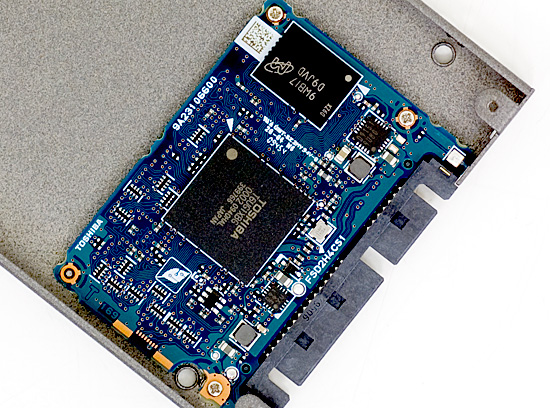
Simply recognizing and accepting the TRIM command is one thing, what the drive’s controller and firmware choose to do with the data is another entirely. Some drives, like Intel’s X25-M and X25-V, appear to immediately flag all TRIMed LBAs for cleaning. This results in an immediate restoration to almost new performance when writing to those LBAs. Other drives, like those based on Toshiba’s T6UG1XBG controller, don’t show an immediate performance benefit when TRIMed. It’s unclear what the controller is doing with the TRIM information, but it doesn’t seem to be in a hurry to do anything with it.
With 32GB of actual MLC NAND on board, Kingston's drive is at a capacity deficit to the X25-V. A cleanly formatted drive only shows 28GB of free space in an OS and you can kiss more than half of that goodbye after you install your OS and a couple of applications. Kingston is hoping to make up for it by outperforming the X25-V. Let's get to it.
A Comparison of Spare Area
All SSDs set aside some percentage of their flash for recycling and bad block allocation. The portion set aside isn't user addressable and is often referred to as Spare Area. Most consumer MLC drives have about 7% of their total flash capacity reserved for use as spare area. Intel's X25-V is no different. The table below shows the available space vs. total NAND capacity on the drive for both the Intel and Kingston drives:
| Drive | Formatted Capacity | NAND Flash | Spare Area % |
| Intel X25-V | 37.27GB | 40.0GB | 6.8% |
| Kingston SSDNow V Series Boot Drive | 27.95GB | 32.0GB | 12.65% |
Intel's X25-V actually has the same percentage of spare area as the X25-M. It's the SSDNow V Series that is a bit perplexing. Formatted capacity for the "30GB" drive is 27.95GB. Given that NAND devices, like all memory, are made in powers of 2 there has to be 32GB of NAND on the drive. Either the Toshiba controller is using over 12% of the total NAND capacity as spare area, or there's only 30GB of usable flash on the drive. The latter could be true if the NAND devices had some existing bad blocks on them.
Either way, the X25-V basically delivers an extra 10GB at the same price point as the 30GB Kingston SSDNow V Series Boot Drive.
The Test
| CPU | Intel Core i7 965 running at 3.2GHz (Turbo & EIST Disabled) |
| Motherboard: | Intel DX58SO (Intel X58) |
| Chipset: | Intel X58 + Marvell SATA 6Gbps PCIe |
| Chipset Drivers: | Intel 9.1.1.1015 + Intel IMSM 8.9 |
| Memory: | Qimonda DDR3-1333 4 x 1GB (7-7-7-20) |
| Video Card: | eVGA GeForce GTX 285 |
| Video Drivers: | NVIDIA ForceWare 190.38 64-bit |
| Desktop Resolution: | 1920 x 1200 |
| OS: | Windows 7 x64 |
Sequential Read/Write Speed
Using the 6-22-2008 build of Iometer I ran a 3 minute long 2MB sequential test over the entire span of the drive. The results reported are in average MB/s over the entire test length:
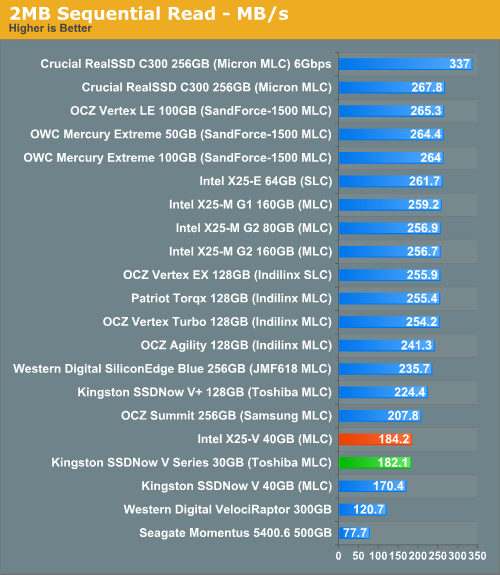
Read performance is identical between the two value drives. The older SSDNow V Series based on the X25-M is actually a bit slower, perhaps due to its older firmware.
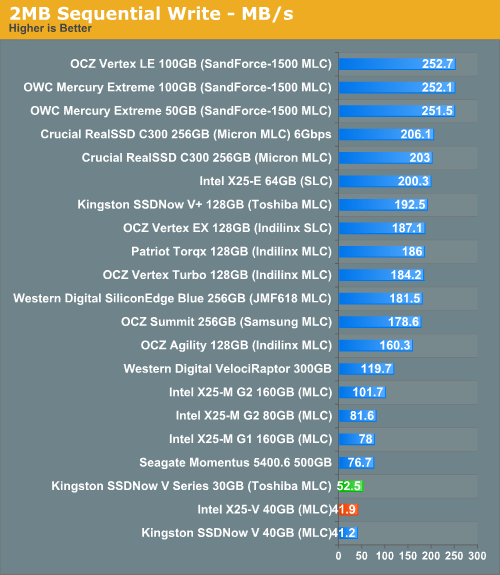
At 41.9MB/s, the X25-V has half the write speed of the 80GB X25-M G2. Kingston's 30GB drive is faster at 52.5MB/s, but we're still slower than the peak sequential transfer rate of a mechanical hard drive or the 80GB X25s.
Random Read/Write Speed
This test reads/writes 4KB in a completely random pattern over an 8GB space of the drive to simulate the sort of random access that you'd see on an OS drive (even this is more stressful than a normal desktop user would see). I perform three concurrent IOs and run the test for 3 minutes. The results reported are in average MB/s over the entire time.
I've had to run this test two different ways thanks to the way the newer controllers handle write alignment. Without a manually aligned partition, Windows XP executes writes on sector aligned boundaries while most modern OSes write with 4K alignment. Some controllers take this into account when mapping LBAs to page addresses, which generates additional overhead but makes for relatively similar performance regardless of OS/partition alignment. Other controllers skip the management overhead and just perform worse under Windows XP without partition alignment as file system writes are not automatically aligned with the SSD's internal pages.
First up is my traditional 4KB random write test, each write here is aligned to 512-byte sectors, similar to how Windows XP might write data to a drive:
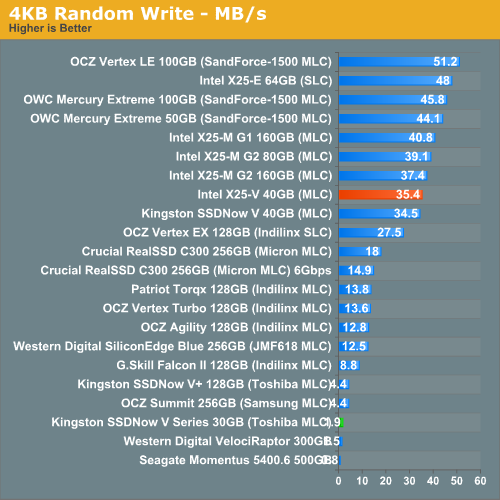
Intel's drives have traditionally done very well in random write tests and the X25-V is no different. Here it performs like a much more expensive X25-M G2. The SSDNow V Series Boot Drive however is at the bottom of the charts in single digits here.
Running 4K aligned writes (similar to Windows 7 or OS X 10.5/6) doesn't improve the situation much in either case:
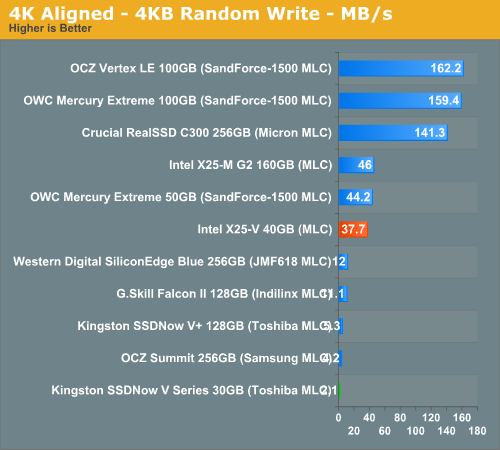
Random read performance is equally strong for Intel:
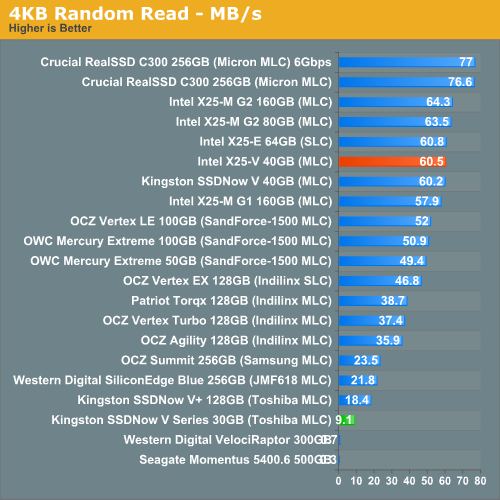
And equally weak for Kingston.
Overall System Performance using PCMark Vantage
Next up is PCMark Vantage, another system-wide performance suite. For those of you who aren’t familiar with PCMark Vantage, it ends up being the most real-world-like hard drive test I can come up with. It runs things like application launches, file searches, web browsing, contacts searching, video playback, photo editing and other completely mundane but real-world tasks. I’ve described the benchmark in great detail before but if you’d like to read up on what it does in particular, take a look at Futuremark’s whitepaper on the benchmark; it’s not perfect, but it’s good enough to be a member of a comprehensive storage benchmark suite. Any performance impacts here would most likely be reflected in the real world.
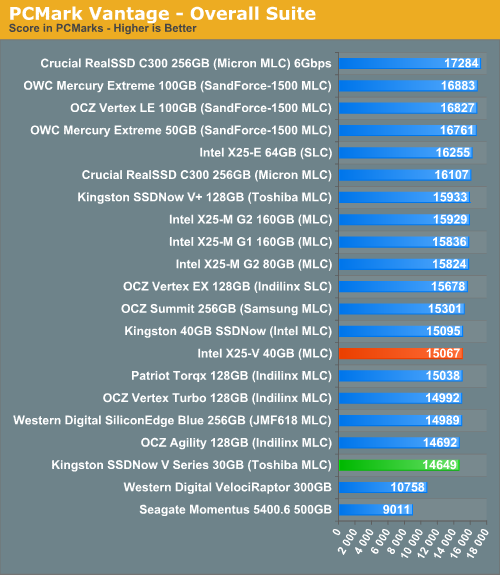
The Intel and Kingston value drives manage to stay close throughout almost all of the PCMark benchmarks. In the Productivity and HDD tests Intel manages to pull ahead by a noticeable margin however.
The memories suite includes a test involving importing pictures into Windows Photo Gallery and editing them, a fairly benign task that easily falls into the category of being very influenced by disk performance.
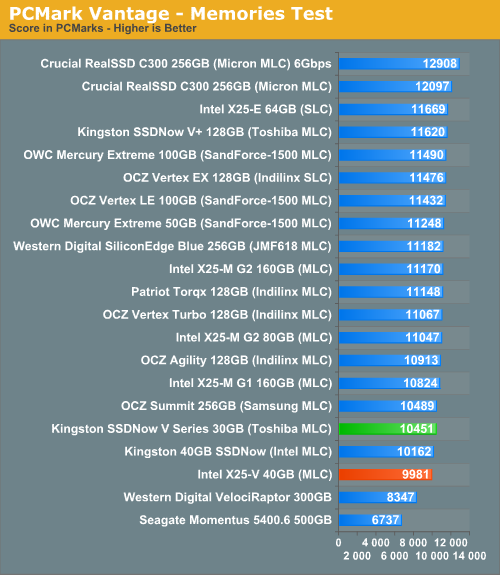
The TV and Movies tests focus on on video transcoding which is mostly CPU bound, but one of the tests involves Windows Media Center which tends to be disk bound.
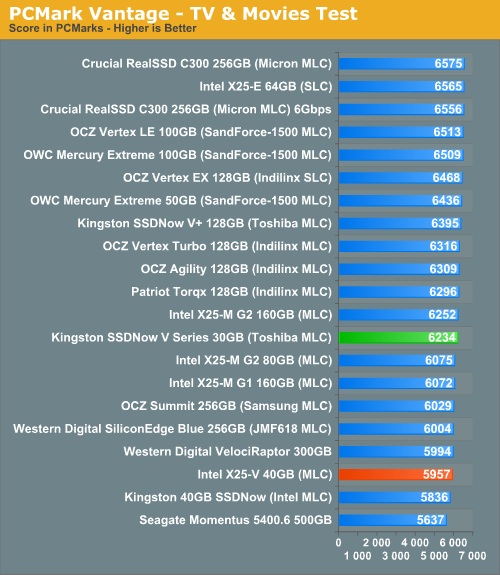
The gaming tests are very well suited to SSDs since they spend a good portion of their time focusing on reading textures and loading level data. All of the SSDs dominate here, but as you'll see later on in my gaming tests the benefits of an SSD really vary depending on the game. Take these results as a best case scenario of what can happen, not the norm.
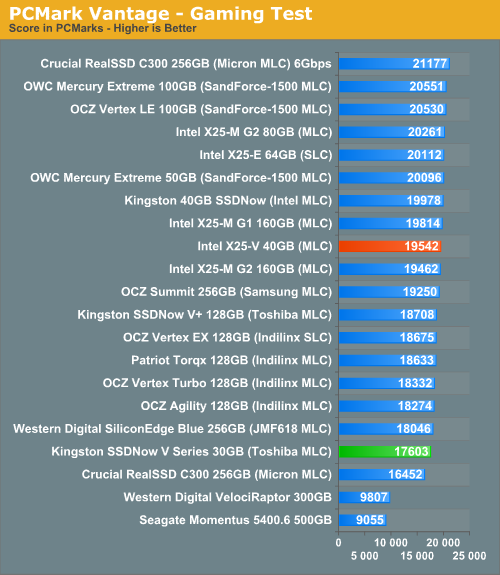
In the Music suite the main test is a multitasking scenario: the test simulates surfing the web in IE7, transcoding an audio file and adding music to Windows Media Player (the most disk intensive portion of the test).
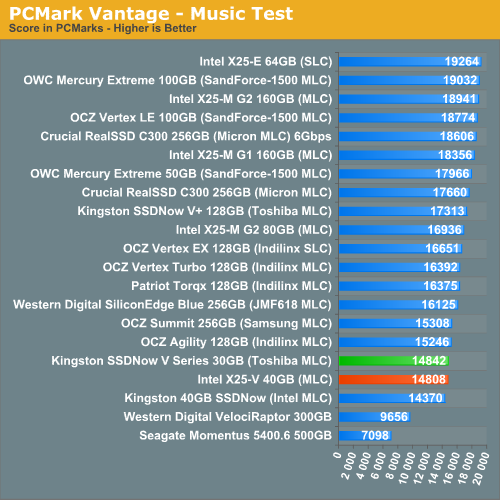
The Communications suite is made up of two tests, both involving light multitasking. The first test simulates data encryption/decryption while running message rules in Windows Mail. The second test simulates web surfing (including opening/closing tabs) in IE7, data decryption and running Windows Defender.
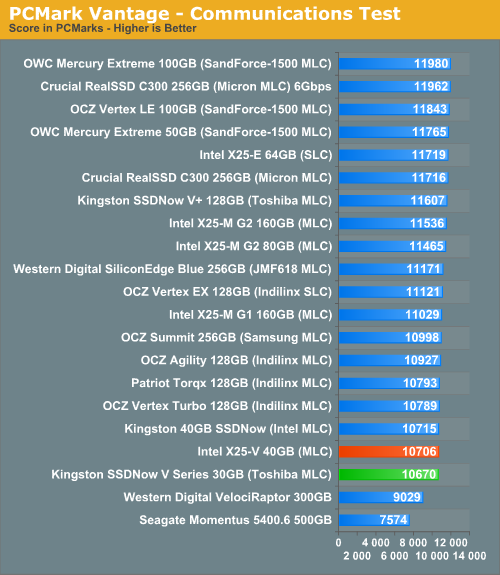
I love PCMark's Productivity test; in this test there are four tasks going on at once, searching through Windows contacts, searching through Windows Mail, browsing multiple webpages in IE7 and loading applications. This is as real world of a scenario as you get and it happens to be representative of one of the most frustrating HDD usage models - trying to do multiple things at once. There's nothing more annoying than trying to launch a simple application while you're doing other things in the background and have the load take forever.
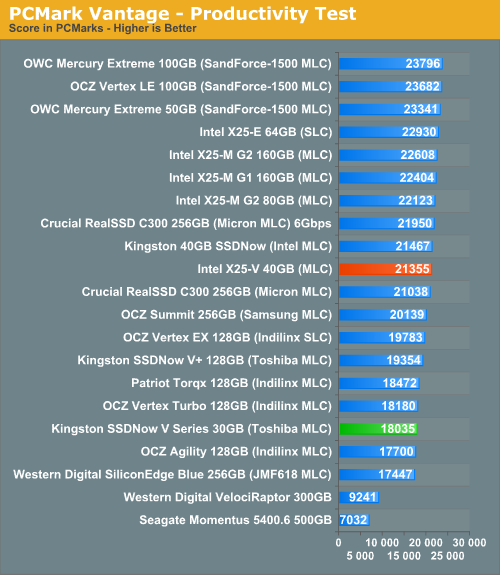
The final PCMark Vantage suite is HDD specific and this is where you'll see the biggest differences between the drives:
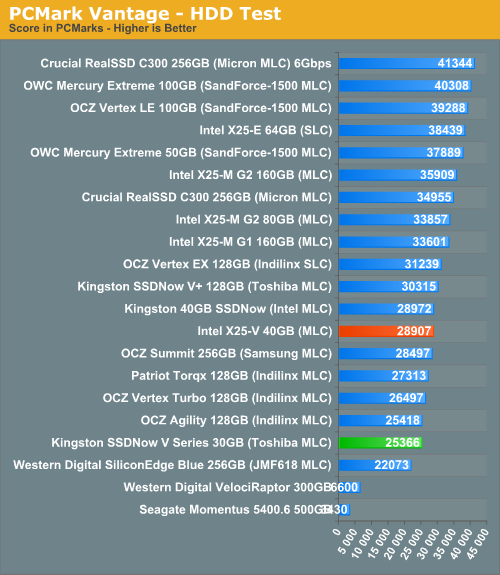
AnandTech Storage Bench
Note that our 6Gbps controller driver isn't supported by our custom storage bench here, so the C300 results are only offered in 3Gbps mode.
The first in our benchmark suite is a light usage case. The Windows 7 system is loaded with Firefox, Office 2007 and Adobe Reader among other applications. With Firefox we browse web pages like Facebook, AnandTech, Digg and other sites. Outlook is also running and we use it to check emails, create and send a message with a PDF attachment. Adobe Reader is used to view some PDFs. Excel 2007 is used to create a spreadsheet, graphs and save the document. The same goes for Word 2007. We open and step through a presentation in PowerPoint 2007 received as an email attachment before saving it to the desktop. Finally we watch a bit of a Firefly episode in Windows Media Player 11.
There’s some level of multitasking going on here but it’s not unreasonable by any means. Generally the application tasks proceed linearly, with the exception of things like web browsing which may happen in between one of the other tasks.
The recording is played back on all of our drives here today. Remember that we’re isolating disk performance, all we’re doing is playing back every single disk access that happened in that ~5 minute period of usage. The light workload is composed of 37,501 reads and 20,268 writes. Over 30% of the IOs are 4KB, 11% are 16KB, 22% are 32KB and approximately 13% are 64KB in size. Less than 30% of the operations are absolutely sequential in nature. Average queue depth is 6.09 IOs.
The performance results are reported in average I/O Operations per Second (IOPS):
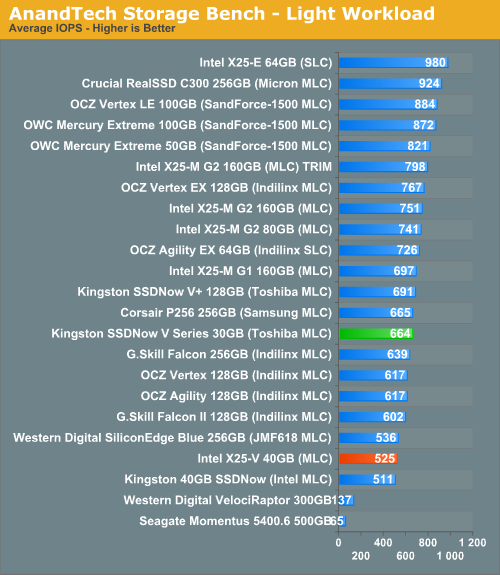
Intel's X25-V performs virtually identically to the older Kingston 40GB Boot Drive. The new 30GB drive does have the advantage though, performing much more like an Indilinx drive than a scaled down X25-M thanks to its higher sequential write speed.
If there’s a light usage case there’s bound to be a heavy one. In this test we have Microsoft Security Essentials running in the background with real time virus scanning enabled. We also perform a quick scan in the middle of the test. Firefox, Outlook, Excel, Word and Powerpoint are all used the same as they were in the light test. We add Photoshop CS4 to the mix, opening a bunch of 12MP images, editing them, then saving them as highly compressed JPGs for web publishing. Windows 7’s picture viewer is used to view a bunch of pictures on the hard drive. We use 7-zip to create and extract .7z archives. Downloading is also prominently featured in our heavy test; we download large files from the Internet during portions of the benchmark, as well as use uTorrent to grab a couple of torrents. Some of the applications in use are installed during the benchmark, Windows updates are also installed. Towards the end of the test we launch World of Warcraft, play for a few minutes, then delete the folder. This test also takes into account all of the disk accesses that happen while the OS is booting.
The benchmark is 22 minutes long and it consists of 128,895 read operations and 72,411 write operations. Roughly 44% of all IOs were sequential. Approximately 30% of all accesses were 4KB in size, 12% were 16KB in size, 14% were 32KB and 20% were 64KB. Average queue depth was 3.59.
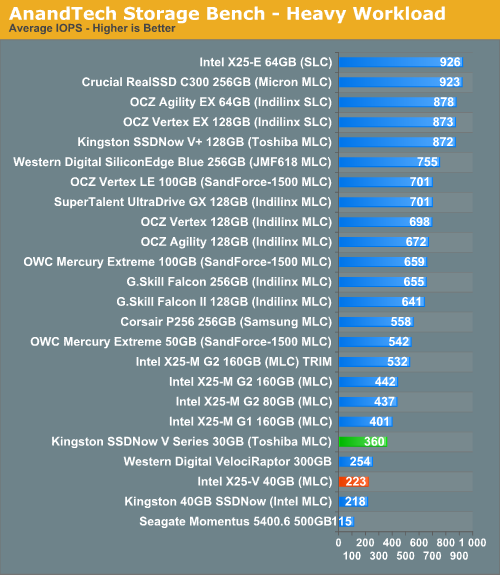
Crank up the sequential writes and Kingston's lead grows. The 30GB V series drive almost performs like an X25-M G1 in this case. The X25-V on the other hand performs more like a low latency VelociRaptor. Still better than a hard drive, but don't expect to copy files any faster.
The gaming workload is made up of 75,206 read operations and only 4,592 write operations. Only 20% of the accesses are 4KB in size, nearly 40% are 64KB and 20% are 32KB. A whopping 69% of the IOs are sequential, meaning this is predominantly a sequential read benchmark. The average queue depth is 7.76 IOs.
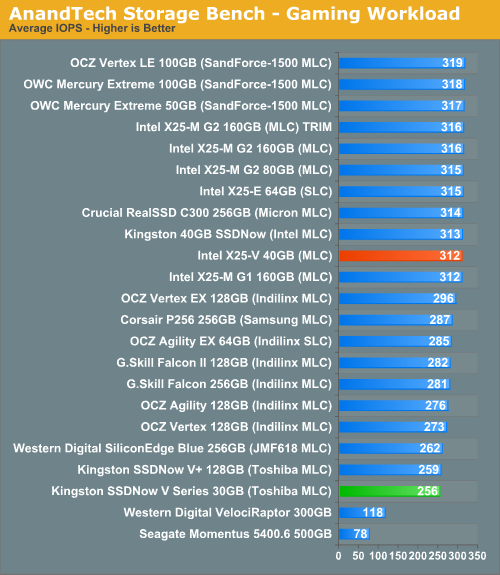
With both Intel and Kingston equal in sequential read performance, the differentiating factor here is strictly random read performance where the X25-V has the edge.
Final Words
When Kingston released its 40GB version of Intel's X25-M last year, I liked it a lot. At $125, I still like the X25-V especially now that it has TRIM support. It's unfortunate for those who bought the Kingston drives last year, but it looks like there is a way to get TRIM working on your drives as well.
The X25-V is a great way to get an SSD into your system if you're not quite ready to splurge on a larger drive. With roughly 37GB of free space to install an OS and apps to, you can easily get your most frequently used programs on the drive. Pair it up with a cheap TB hard drive and you'll have ultra fast storage and a ton of capacity for under $250. Or if you're looking for something to make your travel notebook/netbook a lot snappier, the X25-V is perfect. The limited capacity does have performance implications as there's potentially fewer blocks to be used for cleaning, however TRIM helps alleviate that as an issue assuming you have a TRIM enabled OS.
Intel is quick to point out that pairing up two X25-Vs can give you more performance than a single 80GB X25-M for around the same price. While I'm still looking at RAID performance, the problem is that today there's no way to pass the TRIM command to drives in a RAID array. You gain better sequential performance and concurrent IOPS, but you have no way to actively curb performance degradation. In my opinion, that's not a worthy tradeoff. Intel did hint that its driver teams are looking at ways to pass TRIM down to RAID arrays however.
Kingston's answer to the X25-V is very interesting. You do give up another 10GB of space compared to the Intel drive for a formatted capacity of around 28GB, but in exchange you get better sequential write performance. Ultimately the tradeoff here is between sequential write speed and random read/write speed. The former is Kingston's advantage, while the latter is the X25-V's domain. PCMark Vantage favors Intel's X25-V, while our own storage bench preferred Kingston's 30GB Boot Drive. Given the X25-V's capacity and random read/write performance advantages, Intel gets the nod here over Kingston's 30GB drive if you're looking for a sub-$130 SSD. Note that if Kingston's pricing does manage to stay significantly lower than Intel's (thanks to Newegg's current pricing after MIR), Kingston might be a good alternative if you're looking to spend as little as possible and don't mind giving up some capacity for it.
While it's good to see competition at the low end of the SSD spectrum, I'm not expecting to see much more movement here until 25nm flash hits the market in Q4.







